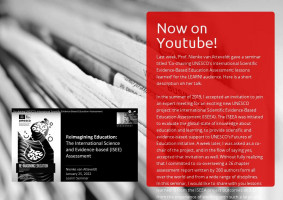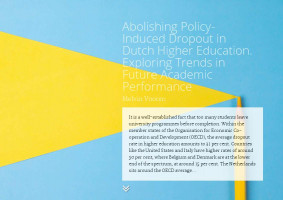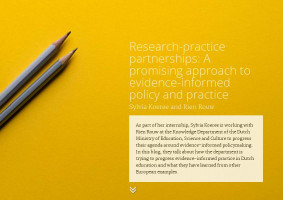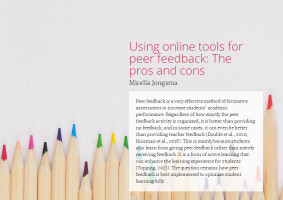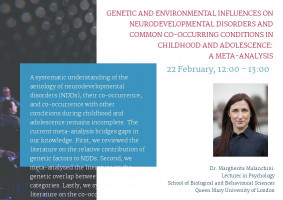It is a well-established fact that too many students leave university programmes before completion. Within the member states of the Organisation for Economic Co-operation and Development (OECD), the average dropout rate in higher education amounts to 31 per cent. Countries like the United States and Italy have higher rates of around 50 per cent, where Belgium and Denmark are at the lower end of the spectrum, at around 15 per cent. The Netherlands sits around the OECD average...
It is a well-established fact that too many students leave university programmes before completion. Within the member states of the Organisation for Economic Co-operation and Development (OECD), the average dropout rate in higher education amounts to 31 per cent. Countries like the United States and Italy have higher rates of around 50 per cent, where Belgium and Denmark are at the lower end of the spectrum, at around 15 per cent. The Netherlands sits around the OECD average.
...it has been largely ignored that a sizable proportion of dropout can be policy-induced.
Because dropout is such a widespread phenomenon, policymakers have used a lot of different programmes to reduce dropout. According to the literature, most of these remediation programmes are found to have no impact, or a negative impact, worsening dropout figures instead of improving them. Financial aid programmes, aimed at providing extra funds to extend the study duration are found to have a positive impact. However, it has been largely ignored that a sizable proportion of dropout can be policy-induced.
What are policy-induced dropouts?
In countries where academic dismissal policies are enforced, students are required to leave the programme in case of poor academic performance at the end of their freshman year. In the context of Dutch academic dismissal policies, poor academic performance is generally defined as having accumulated less than 70 per cent of the credits in the first year, i.e. 42 ECTS. As a result, the policy increases first-year dropout rates. The students who are forced to drop out as a result of academic dismissal are referred to as policy-induced dropouts (PIDs).
Previous research has found that the policy increases graduation rates for the remaining students (Sneyers and De Witte, 2017). However, other research by Cornelisz et al. (2019) has found that those students who are forced to leave the programme due to academic dismissal actually switch to a similar programme at the same university, or the same programme at a different university.
Considering this, we can conclude that academic dismissal policies are quite costly because switching to a similar programme elsewhere usually implies moving to a different town and starting all over again.
Our research objectives
In the first year of the Covid-19 pandemic, the Dutch government abolished first-year academic dismissal in the beginning of the second semester, on March 19, 2020. As a result of this, students who would otherwise have been academically dismissed were allowed to continue their studies in year 2. This circumstance provides a unique opportunity to monitor the performance of PIDs in the second year of the programme. However, the Covid-19 crisis also comes with a methodological challenge, because semester 2 performance could have been affected by other factors induced by the Covid-19 pandemic, such as grading leniency, online learning, or mental health effects.
In order to address this, our research addresses three objectives: 1) determining the number of students who drop out due to academic dismissal, i.e. the PIDs; 2) examining second-year performance of PIDs who were allowed to continue as a result of Covid-19; 3) calculating the average study duration for PIDs until obtaining a bachelor’s degree.
We find that within the Vrije Universiteit Amsterdam, 22.4 per cent of all dropouts in year 1 are PIDs [policy-induced dropouts].
Our findings
The main challenge in identifying PIDs in the Covid-19 cohort is that you cannot compare achieved credits at the end of the programme with achieved credits in earlier cohorts, due to the aforementioned Covid-19 effects on student performance, including mental health effects. To address this, we use a machine learning model to predict expected credits at the end of year 1 based on only pre-covid-19 characteristics, i.e. performance in semester 1 of year 1 and individual background characteristics.
Because the first semester was not affected by the Covid-19 crisis, we can compare the expected credits of
students in the Covid-19 cohort with the expected credits of those in earlier cohorts. Doing so, we can identify the PIDs and observe their performance in year 2. We find that within the Vrije Universiteit Amsterdam, 22.4 per cent of all dropouts in year 1 are PIDs.
As a next step, we examine second-year performance of PIDs. In the earlier cohorts, we can see that there is a substantial share of students below the academic dismissal threshold who are allowed to continue in year 2, despite the fact that they should have been dismissed based on their performance. In other words, these students got a waiver for the academic dismissal policy. We then compare the second-year performance of the students below the academic dismissal threshold in those earlier cohorts (i.e., those with a waiver) with the students below the threshold in the Covid-19 cohorts. We see that the performance of PIDs and students who got a waiver is not significantly different. Because the second-year performance of students with a waiver is the same as the performance of the PIDs, we assume that this remains the same in later years as well.
Why do we dismiss PIDs based on an arbitrary academic dismissal threshold if they perform equally well as students who got a waiver?
Conclusion
In other words, we can conclude that 22.4 per cent of first-year dropouts at the Vrije Universiteit Amsterdam are policy-induced (PIDs). These PIDs do not perform significantly different compared to students who got a waiver for the academic dismissal programme. It seems that students have a constant individual study pace, and from a student perspective, there does not seem to be a strict “unsuitability” threshold in terms of year-one performance. In terms of educational inequality, this brings up an important issue as well. Why do we dismiss PIDs based on an arbitrary academic dismissal threshold if they perform equally well as students who got a waiver?
Acknowledgement
This blog is based on research by Melvin Vooren, Ilja Cornelisz, Martijn Meeter, and Chris van Klaveren
(1)_w400_h440_1.jpg)
Melvin Vooren
ACLA - Amsterdam Center for Learning Analytics
Faculty of Behavioural and Movement Sciences, Educational Studies
Email - m.vooren@vu.nl




